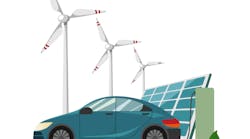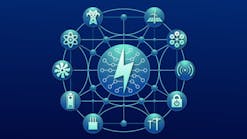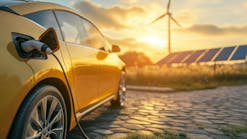It is difficult to fathom the impact that renewable energy technology is having on power delivery systems. Over the last few years, we have seen technology advancing at a rate far beyond earlier predictions. It is happening faster than ever before and we will see dramatic impacts of those changes in the next few decades.
What are some of those impacts?
The first big change is that those who have been solely consumers of energy in the past will be able to become “prosumers” — that is, both producers and consumers — of energy. This will have fundamental implications for our power grid. For the first 100 years of its history, the electric power grid was designed to deliver energy one way: from large, centralized production plants to industrial, commercial and residential customers. Just as the arrival of electricity fundamentally changed society, more social impacts are on the way as anyone with the money can become a net excess producer of electricity.
The challenge is that the distribution grid was not designed to operate in two directions. Engineers are going to have to figure out how to remake the distribution system to allow for a new distributed generation model. It will need to be a two-way power distribution system that is even more reliable and resilient than in the past. It will need to be flexible enough to accommodate new loads — such as an electrified transportation fleet — and be equipped with new devices to communicate with producers and consumers in real time.
To understand what this means, it is important to understand the most fundamental operating principle of our electric power system: supply and demand must be in balance at all times in order to keep the frequency stable. To encourage producers and consumers to balance supply and demand, the wholesale price of electricity changes throughout the day.
The proliferation of solar energy in California is a good illustration. In California and other parts of the west, the power system was designed primarily to deliver the energy needed for cooling demand in a diverse climate that ranges from desert to mountains. Traditionally, hydroelectric energy was brought from the river basins in the Pacific Northwest, and nuclear and coal power from large generating stations primarily in Arizona to California, to meet these energy needs.
But all that began to change in recent years with the rapid increase in use of solar power. Solar is now becoming a significant generation source, and California is at the point of becoming a net exporter of electricity during peak solar production periods. One of the impacts of this is periods of free wholesale power. In May 2018, for example, 9% of the time wholesale electricity in California was priced at zero or even negative to incent consumers to use it.
A similar phenomenon is taking place in the Texas retail market, where some suppliers are offering free electricity overnight. How can that be? This is because there is an excess supply of wind energy at night that far exceeds the demand on the system. So, while wind power is typically at its highest production rate, demand is at its lowest. In a deregulated market like Texas, where prices move with market signals and many consumers have a choice of suppliers, prices can go negative because the wind producers do not earn their tax credits unless they produce the energy. Thus, wind producers “sell” energy at negative rates — that is, pay consumers to use it — up to just below the value of the production credit they are receiving.
These market signals in California, Texas and a few other places are unlike anything the electric utility industry has seen. If energy is free at night or when the sun is shining in the California desert, it changes the way we design the distribution system.
Until now, the electric supply and power delivery system has been designed to meet all the demand that exists, plus a certain reserve margin to carry unexpectedly high peak demand. Today, we calculate peak demand based on historical patterns, then build enough supply and power delivery infrastructure to meet it. With load factors not being ideal, such as peak demand being considerably higher than average demand, this leads to building a lot of reserve capacity that is not used very often. This supply-side approach to balancing supply and demand will need to change as larger and larger shares of generation are provided by intermittent sources. New and innovative ways to manage both the supply-side and the demand-side of the equation must be found.
Looking again to California, the Los Angeles Department of Water and Power, which operates electrical infrastructure at Hoover Dam, is looking at ways to take excess solar energy to power their large pumps in reverse, moving water upstream to storage. It’s a US$3 billion proposal that would take excess renewable energy when it is priced at or below zero to power pumps instead of curtailing production. The water could be stored indefinitely for use later in the day, later in the week, or even during a different season. It would be a way to effectively store solar and wind energy as hydroelectricity to maintain supply and demand balance during low-supply periods from the renewables.
Beyond wind and solar, another disruptor in this supply/demand equation is the electrification of transportation. The electric grid can support the charging requirements of the relatively few electric vehicles (EVs) now on the road but this is likely to change very soon. Nearly every automaker has plans to bring out new models of EVs and most forecasters agree that by the early 2030s, up to 40% of the vehicles on the road — from cars to large trucks to buses — will be electric. Not only will the charging requirements fundamentally affect the distribution grid, but vehicle-to-grid (V2G) technology is also advancing quickly. Batteries in EVs will create both large loads and a potential distributed generation source.
While the inevitable transition of all transportation from liquid-based fuels to electric energy is widely discussed, there is not as much discussion about the increases in investment needed in the power distribution infrastructure. The initial plan is to offer special time-of-use rates that will incent EV owners to charge at night, or during other periods when there is excess capacity in the power generation and delivery infrastructure. With the way the electrical system is now configured, this would seem to be the most cost-effective solution. However, with more and more solar and wind coming on the grid, it won’t be long before these low-cost times are moving around during the day. Utilities or other suppliers of energy will have to communicate with EV owners in real time. Maybe the supplier will offer cost incentives to charge EVs during the middle of the day, taking that excess low-cost energy off the grid and having a full charge when they go home.
The impacts on infrastructure of this new reality offer exciting challenges to engineers. We will have the opportunity to create a two-way electrical distribution system that is much more flexible and resilient than it is today. For example, we are investigating electronic transformers to allow the voltage or reactive power flow to be actively managed. We are looking at power electronics in inverters to allow them to provide real-time support of the grid and keeping it operating during disturbances. We are installing all kinds of sensors, controls, and communications devices to keep consumers and producers connected, controlling the flow of power through transformers and switches. With more sensors and faster communications infrastructure for control systems, we can create an even more resilient power system than we have today.
Recent natural disasters bring another advantage of grid transformation into focus. In the face of hurricanes, massive wildfires, historic floods, ice storms, blizzards, and so forth, a power delivery system that depends on large central-station supply sources is extremely vulnerable to widespread outages. But now, there are other answers. With a new and more flexible energy system that is fundamentally more resilient, we can create networks of microgrids with localized supply and interconnected demand. These systems can communicate locally, creating an interconnected electrical supply even though it might be disconnected from the larger grid. We are already seeing microgrid deployments even though costs are still a barrier, but those costs will come down just like those for other innovations impacting the grid.
None of this discussion can avoid the topic of regulation and finances. Today, the cost of delivering energy is going up while the cost of producing energy is going down.
Though it’s a complex subject, the reality is that regulation is not keeping pace with changes in the power markets. Incentives have dramatically shifted sources of generation while not addressing problems associated with aging delivery infrastructure. We’re potentially building too much infrastructure to meet intermittent demand while not enough infrastructure is being built to create the flexible distribution system we need.
The power system has been a fine example of how to socialize fixed costs across a base of all consumers. Costs are apportioned based on how much energy you buy, with everyone paying some fixed amount, usually called a service charge, to compensate for the benefit of being connected to the grid. But there’s a rising challenge to that system. Today, if you have the money, you can invest in solar power or some other combination of localized energy up to the point of disconnecting from the grid. You can become a net-zero energy consumer. While that works out great for people leaving the system, those left behind are inevitably going to pay higher and higher shares of the fixed costs of the electric system. This a challenge that must be met. Those who don’t have the ability to pay rising shares of fixed costs face the risk of being left “in the dark” with a legacy system no one can pay for.
Technology can provide a lot of answers, but some issues still depend on getting public policy right. It’s encouraging to see regulators in Ohio, Louisiana and many other states pushing their local utilities to consider broader and more holistic solutions than simply adding more and bigger wires, substations and transformers. This has the attention of regulators in most states and all are looking at solutions that will keep the industry moving toward cleaner power and a more flexible two-way grid that maintains the reliability we all expect and depend on. It will not come cheap, but with the right incentives and financial structures in place it will be an exciting future.


